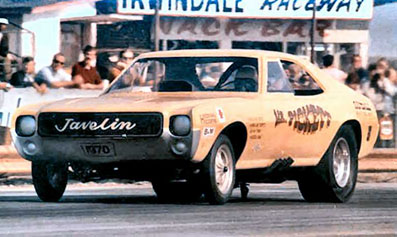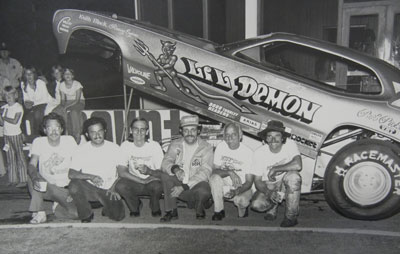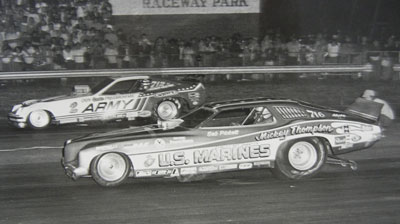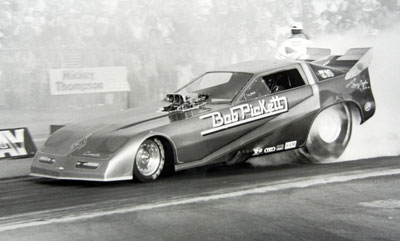

The incredible Mr. Pickett
In 1974, I made my first trip to Irwindale Raceway for a Funny Car show. I don’t remember much of the specifics of the event, but I remember leaving with a crooked little grin on my 14-year-old face after seeing Pete Everett’s Pete’s Lil Demon Funny Car.
Even in my early teen years, I had a fascination with word play, enough to see beyond the connotation of racing possibly being his personal demon and the pitchfork-wielding cartoon devil as the reason for the car’s name. It also was a Dodge Demon. Get it? I probably couldn’t spell double entendre, but I got it. Man, I thought that was great.
I became a fan of his driver, Bob Pickett, right then and there, an admiration that only grew when he later drove one of my all-time favorite floppers, Mickey Thompson’s Grand Am, a feature about which I (still, I promise) am working on. Pickett, the car’s final driver, obviously was on my interview list, and I finally tracked him down last year in Florida, where he is a competition water skier. Though long retired from driving, I thought his long racing career and his current daredevil act at age 70-plus would make interesting reading. I also spoke about Pickett with veteran nitro wrench Pat Galvin, who got his introduction to the sport through his Arleta, Calif., neighbor Mr. Pickett.
Long before he was a Funny Car driver, Pickett was a doorslammer terror at San Fernando Raceway in the late 1950s, first with a Chevy-powered '49 Ford and then, beginning in 1959, a Corvette that ran in E/Stock Sports and won him approximately 75 trophies at San Fernando and other SoCal tracks. Interestingly, this car provided his introduction to Thompson, who was managing Lions Drag Strip at that time when Pickett was giving big head starts to the day’s top runners and chasing them down by midtrack.

Bob Pickett's blown Corvette was one of the baddest doorslammers in SoCal in the late 1950s and early 1960s. (Mike Ditty photo)
|
“Some of the other racers protested my car,” recalled Pickett. “Mickey himself came down from the tower to tear it down, and he declared the car legal."
In 1961, Pickett and new partner Dick Harriman added a blower to the Corvette’s 327 Chevy and ran it in A/Modified Sports under the name Mr. Pickett's 'Vette.
"We had to run mostly exhibition races at the time since the Funny Cars hadn't started coming on the scene yet, and there was really little competition,” said Pickett, whose mount was capable of 140-mph speeds. “I was in on the ground floor of Funny Car.”
Recalled Galvin, “I first met Bob when I was 9 years old -- he was in his 20s and already had the Corvette – and I worked on his cars up through 1975. In my mind, that Corvette was one of the first Funny Cars. It was a handful; it didn’t like to go straight.”
A 354 Chrysler supplanted the Chevy, boosting speeds to nearly 160 mph, and when the first Funny Cars began showing up in the mid-1960s, he finally had some competition despite his car’s mostly stock-bodied, stock-wheelbase configuration. A fuel-burning, supercharged 392 Chrysler eventually pushed the Corvette to low-eight-second passes at 185 mph.
As the Funny Car class became more sophisticated, Pickett knew that his Corvette wouldn’t keep pace, so in 1969, he built a Funny Car chassis in his garage, copying the frame designed by Pat Foster for Thompson's famous Mustangs right out of a magazine article.

Pickett's first real Funny Car was this self-built Javelin. It was a real runner but met a dramatic end when it took flight in the lights at OCIR in May 1970. Pickett was knocked unconscious and suffered a broken back in the incident.
|
 |

Pickett returned to racing with a Barracuda in 1971.
|

(Above) Pickett drove Pete Everett's Pete's Lil Demon cars for three seasons. Pictured below in the OCIR winner's circle are Pickett, far right, car owner Pete Everett, second from right, and Pat Galvin, third from left.
|
 |

Pickett spent two tough years (1975-76) behind the wheel of Mickey Thompson's heavy U.S. Marines-sponsored Grand Am.
|

Pickett won two NHRA national events -- the 1977 Springnationals and 1978 Cajun Nationals -- with his own cars.
|

Pickett closed his career in these two cars, running the Arrow (above) until 1982 and the Corvette (below) until 1986, when he retired.
|
 |
“We knew how long the chassis was, so we copied the design right out of the magazine,” he admitted. “We chalk-lined it on the garage floor, tacked it together, then had someone else weld it up. I did all the tinwork myself. I’d never built a car before that. I was just driven.”
All this time, Pickett was still holding down a full-time job as a carpenter, building roofs on large commercial buildings.
“I'd work all day, then come home and work all night [on the race car] and get four hours of sleep, then go back to work. I'd lived it so much it didn’t matter.”
Pickett cloaked his new creation with an AMC Javelin body, and the car flew … literally. After racking up an eye-opening best of 7.25 at 201 mph, the car took flight in the lights May 2, 1970, at Orange County Int’l Raceway’s Big 4 race.
“They said I was dangling the front tires off the ground at 800 feet, and then right in the lights, it went straight up,” recalled Pickett, who was knocked unconscious and suffered a broken back in the wreck. “It went as high as a telephone pole and went a long way and went into the guardrail. I was just telling myself, 'It's not my time.' "
Seven months later, Pickett was back in business with a 1970 Barracuda that ran a best of 6.83 at 216 mph before he sold the car. Pickett began work on a new Mustang but was given the chance to drive Nelson Carter's Super Chief in 1971. That ride also met a calamitous end in a fire, so Pickett jumped behind the wheel of the Mustang but didn’t stay there long because a week later, Everett offered Pickett the seat in his Dodge Demon flopper.
Everett, who owned a service station, had fielded a variety of Funny Cars since the late 1960s with Leroy Hales, an enterprising USC medical-school student who worked at his gas station, at the controls. Hales was badly burned in a fire and retired from driving (and eventually became part of the NHRA Safety Safari presented by AAA), and Pickett took his spot. That began a successful three-year partnership that didn’t end until 1974 and produced a best pass of 6.49 at 225 mph.
“I had a great career with Pete; he was a great guy,” said Pickett. “He let me run the whole deal. We had a lot of fun. We even went to Indy and back east to some match races.”
“That car was always competitive,” remembered Galvin. “Pete didn’t have a big budget; all of our stuff was clean and nice, but we didn’t have spares, so we always ran it pretty conservatively.”
In 1975, Pickett, on the recommendation of longtime Thompson employees Steve Montrelli and Dale Pulde, took over the reins of M.T.'s U.S. Marines-sponsored Grand Am after Larry Arnold quit after the Gatornationals. Newly graduated from high school, Galvin went on the road with Pickett and the car.
“Bob could pretty much do anything on a car,” recalled Galvin. “There wasn’t much he couldn’t do, but it wasn’t really a highly financed deal like it looked. Mickey would get half of the money off the top, and it was hard to run a car that way.”
The Grand Am body also was heavy, and Pickett struggled with it through two versions and two seasons before switching to an Old Starfire body in 1977, which proved to be a watershed year for him. He scored his first NHRA national event victory at the NHRA Springnationals, defeating Don Prudhomme in the final, 6.22 to 6.26, and won the Manufacturers Funny Car Meet at OCIR.
Like many who had driven for him, Pickett found that he couldn’t work under the financial arrangements required by Thompson and struck out on his own in 1978 and won the Cajun Nationals over Tom Anderson. The Marines sponsorship dried up in mid-1979, so Pickett sold the car and switched to an Arrow sponsored by Spartan Financial Corp., a construction financing company owned by his good friend Ed Secard.
He moved to Michigan in 1981 to be closer to the match race scene and shared a shop with Tim Grose and others. He ran the Arrow for a couple of seasons, followed by a Corvette (one of those hideous Bruce Iversen-built bodies derisively dubbed “the shoe” by drag photographers) with sponsorships from companies like Pro-tec and Hosemate.
Pickett’s last race was the 1986 Keystone Nationals, where his 5.997 pass fell just short of Scott Kalitta’s bump-riding 5.984.
“I finished 17th and blew up the truck engine on the way home and said, ‘That's it,' and quit,” he said. “I left the car in the garage for a few years before I got up the nerve to sell it.”
Competitive by nature, Pickett soon found himself lost without an outlet.
“Like any sports person, you lose your friends, you lose yourself,” he said. “I went through several years of depression until I started water skiing, and it brought me back to life.”
Pickett moved to Florida and began his second career at the unlikely age of 58, in water-ski racing, whipping his body around buoys at 50 mph with an ever-shortening rope length until the inevitable wipeout. Success did not come quickly. Or painlessly.
“Driving a car was instinct to me; water skiing was not,” he admitted. “It took me 10 years to get it. It’s cheaper than racing but almost as dangerous. Guys hang themselves on the ropes or get their arms caught. I’ve broken a couple of ankles, torn my rotator cuff, and use a knee brace, but you pick yourself up, get a few stitches, and go on, just like with a Funny Car. You get burned, a broken back, detached retinas, and you fix it and go on. Right now, I’m the only one in my [70 and older] class, so I’m the champion. Outlive everyone; that's how you win.”
Regardless of age, all these years later, Bob Pickett is still definitely a winner in my book.



















































